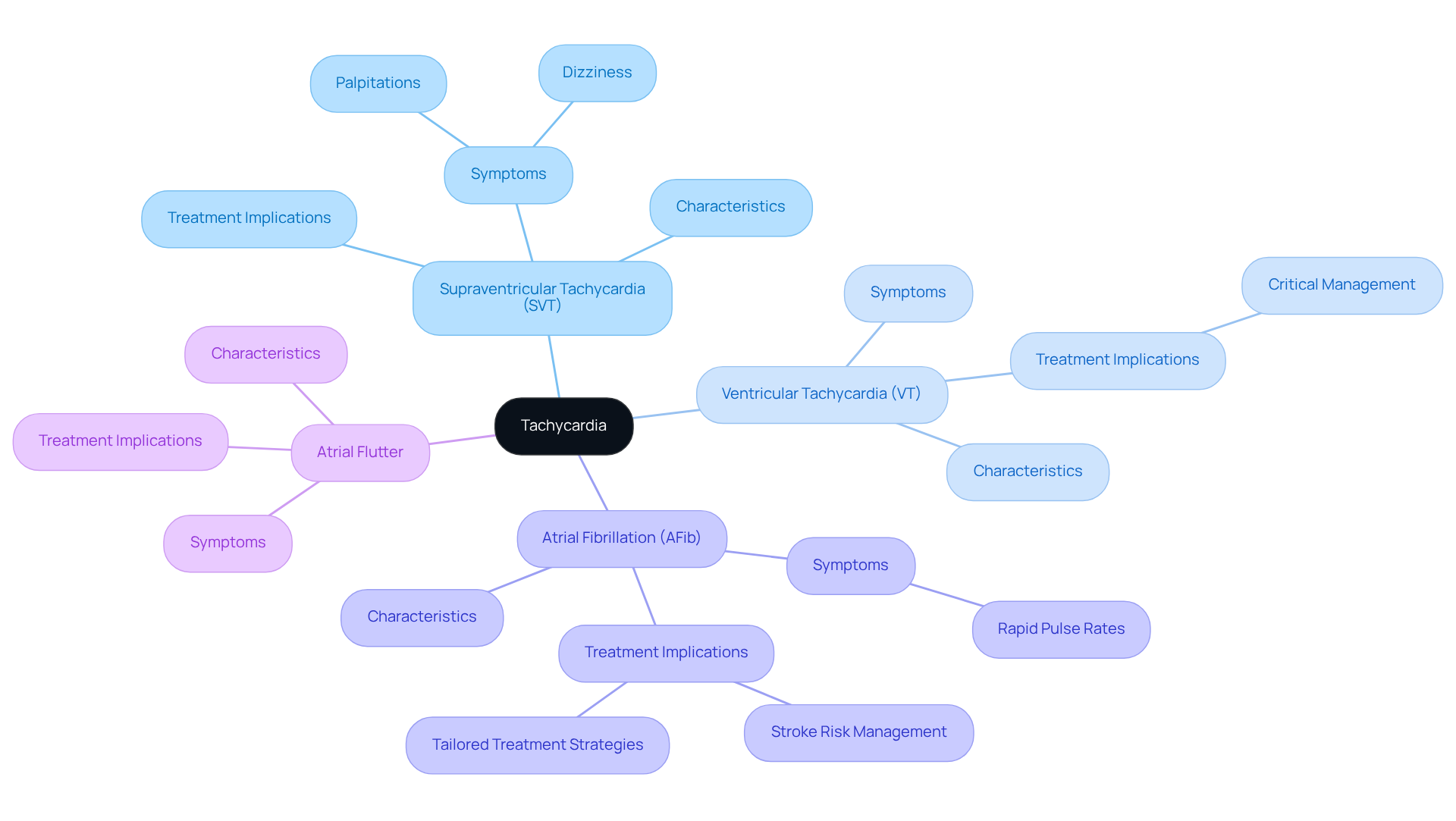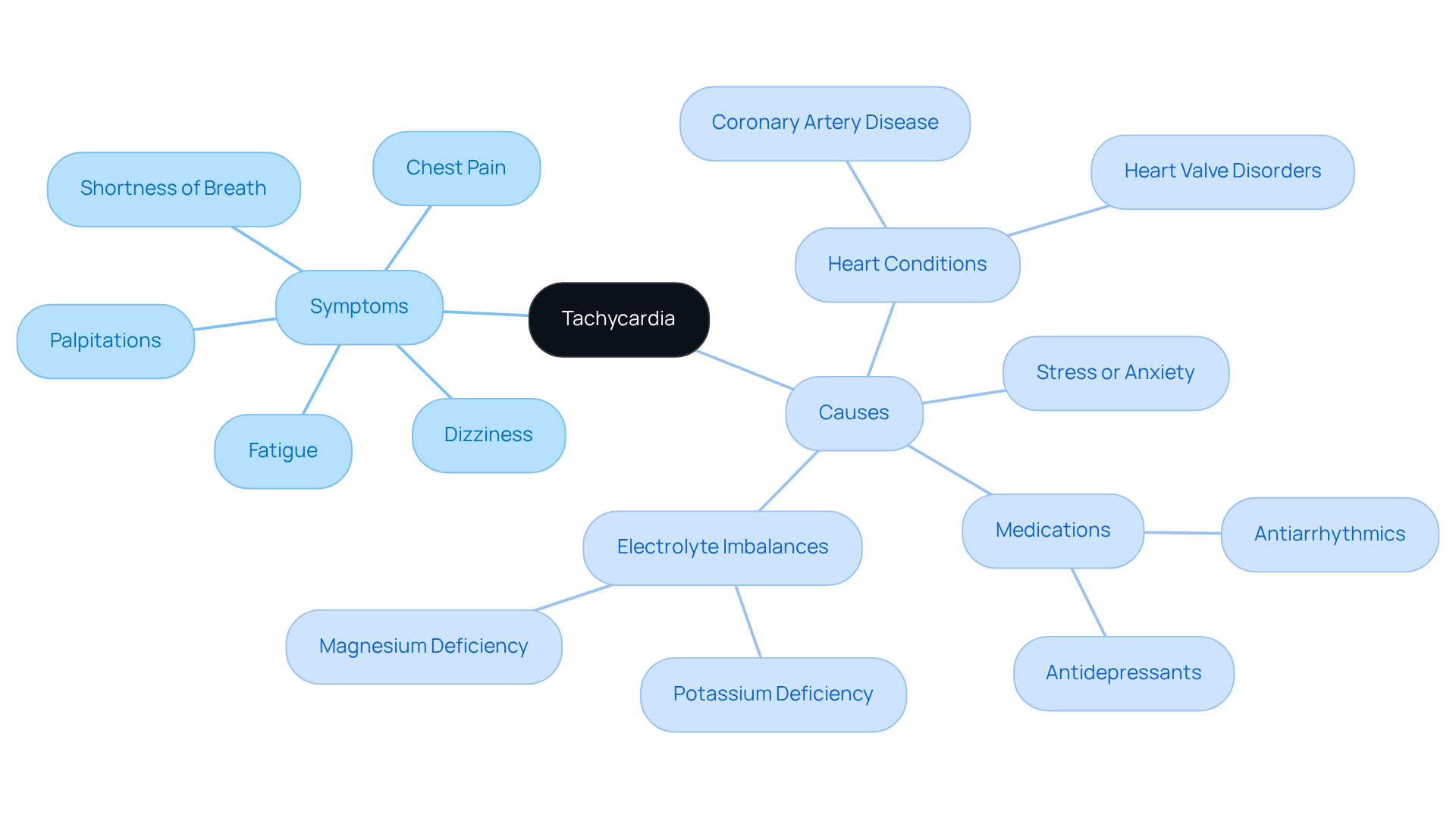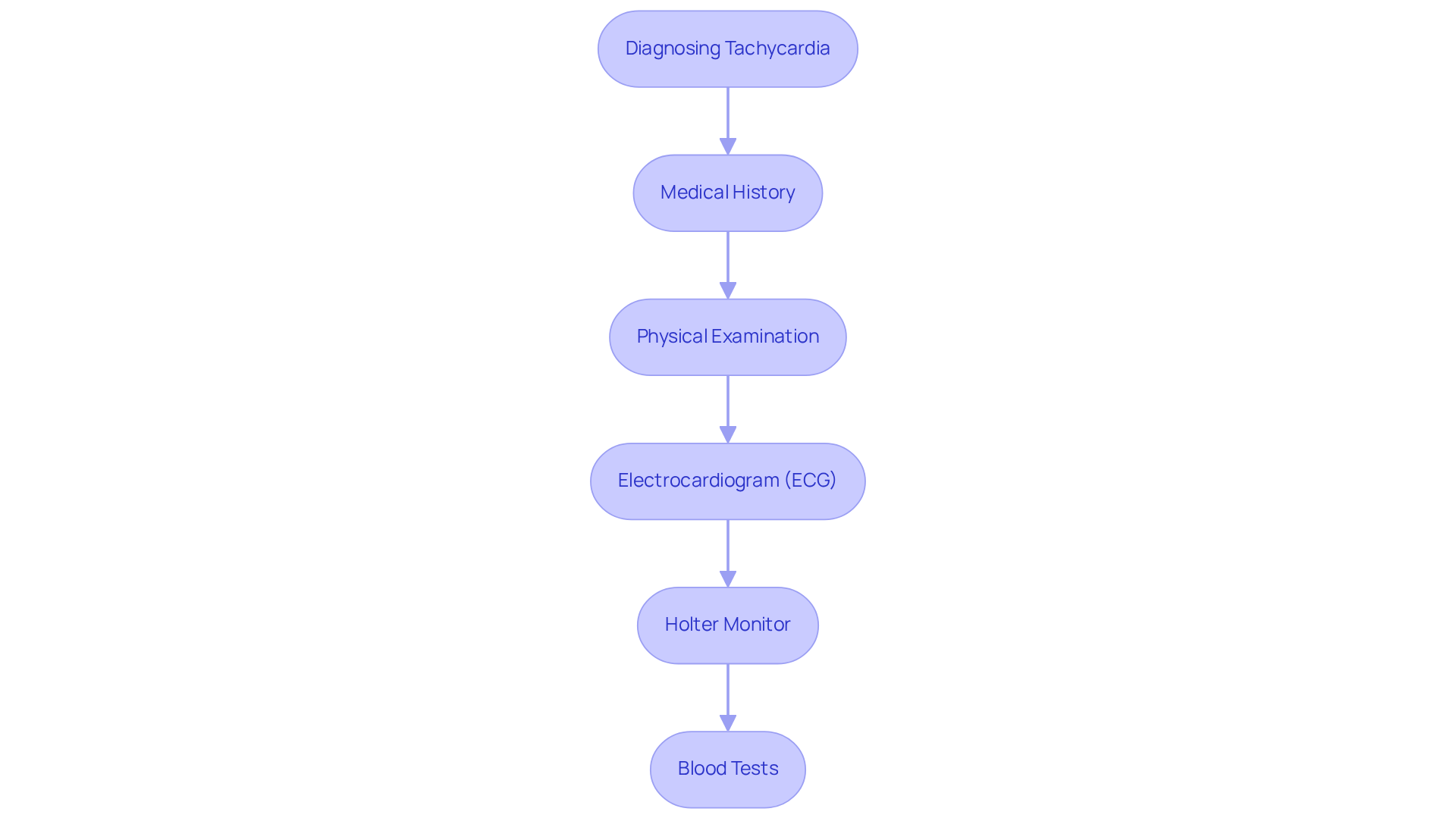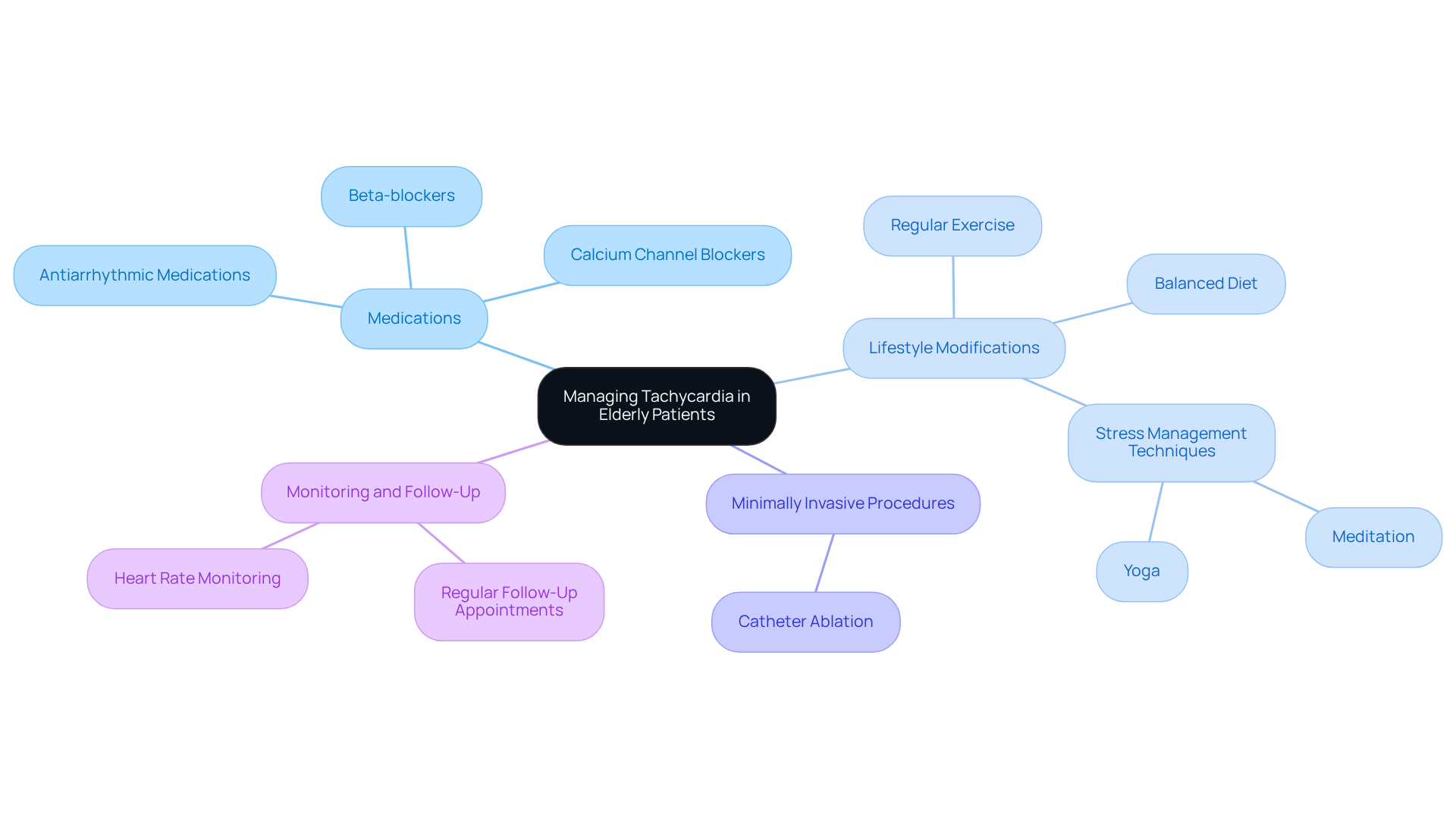


This article addresses a significant concern for many elderly patients: the treatment of rapid heart rate, known as tachycardia. It emphasizes the critical need for timely and effective management to prevent severe complications, ensuring that patients feel understood and supported in their health journey.
By detailing various types of tachycardia, along with their symptoms, causes, and treatment options—including medications, lifestyle changes, and minimally invasive procedures—this article highlights the importance of personalized care. Such tailored approaches are essential in improving health outcomes for older adults, making them feel valued and cared for.
In addition to this, it is vital to recognize that each patient’s experience is unique. The journey toward better heart health can seem daunting, but with the right support and information, patients can take proactive steps toward managing their condition.
This article encourages elderly patients to seek help and engage in discussions about their health. Remember, you are not alone in this journey; compassionate care is available to guide you every step of the way.
Tachycardia, a condition characterized by an elevated heart rate often exceeding 100 beats per minute, can pose significant risks, particularly for the elderly. As we age, our bodies become more susceptible to cardiovascular issues, making it essential to understand and address rapid heart rates in this vulnerable population.
This article explores the complexities of managing tachycardia in older adults, examining various types, symptoms, and effective treatment options.
How can healthcare providers ensure timely and personalized care to mitigate the dangers associated with this condition? Together, we can navigate this journey towards better heart health.
Tachycardia, characterized by a rapid pulse often exceeding 100 beats per minute in adults, can be particularly concerning for older patients. As we age, our cardiovascular function changes, and many individuals face multiple health challenges. Recent studies indicate that older adults with atrial fibrillation (AF) are at a heightened risk for all-cause mortality and heart failure. This underscores the importance of effective rapid heart rate treatment in managing their health.
This condition can manifest in various forms, including:
Each presenting unique characteristics and treatment needs. For example, SVT may often be managed with vagal maneuvers or medications, while VT might require more invasive options, such as catheter ablation or the placement of a cardioverter defibrillator (ICD).
Recognizing the need for rapid heart rate treatment early is vital, as it can lead to serious complications like heart failure, stroke, or even sudden death if not addressed. In the elderly population, where cardiovascular disease is prevalent, timely intervention, including rapid heart rate treatment, can significantly enhance patient outcomes. Simple lifestyle changes, such as managing stress and adjusting dietary habits, have been shown to reduce the frequency of rapid heartbeats and improve overall cardiovascular health.
Understanding how affects the health of older adults is essential, as it can worsen existing conditions and lead to more hospital visits. Therefore, healthcare providers must prioritize early diagnosis and personalized rapid heart rate treatment plans to mitigate the risks associated with elevated heart rates in older individuals. Remember, you are not alone in this journey; seeking help and support can lead to better health and well-being.

Tachycardia encompasses various types, each with distinct characteristics and implications for treatment, particularly in older adults.
Supraventricular Tachycardia (SVT) is a type that originates above the heart's ventricles and is prevalent among older adults. Symptoms often include palpitations and dizziness, which can significantly impact daily life. At Amavita Heart and Vascular Health, we utilize advanced diagnostic tools to continuously monitor individuals, ensuring timely interventions that enhance outcomes.
Ventricular Tachycardia (VT) is a more serious condition that arises from the ventricles and poses severe risks, including cardiac arrest. Its management is critical, especially in the elderly, who may have underlying health issues. Our expert team is equipped to provide innovative treatments that effectively address these serious conditions.
[Atrial Fibrillation](https://amavita.health/home) (AFib) is common in older populations and can lead to rapid pulse rates, increasing the risk of stroke. Recent studies indicate that new-onset AF occurs in approximately 12.7% of older adults over a decade, underscoring the importance of monitoring and early intervention. At Amavita, we focus on thorough arrhythmia management, providing advanced therapies that restore the heart's natural rhythm while reducing disruption to individuals' lives. We also recognize the racial and ethnic disparities in the management of AFib and are committed to addressing these challenges through tailored treatment strategies.
Atrial Flutter is similar to AFib, involving rapid heartbeats but maintaining a more organized rhythm. Understanding this distinction is vital for effective treatment.
Recognizing these variants is essential for developing tailored treatment plans that cater to the unique physiological responses of elderly patients, ensuring they receive the most appropriate and effective care. Amavita Heart and Vascular Health is committed to enhancing cardiovascular care through seamless coordination and patient-centered approaches. We invite you to reach out for support, as your is our priority.

Symptoms of rapid heartbeat can manifest differently among individuals, particularly in older adults. It's important to recognize these signs, which may include:
Tachycardia is defined as a heart rate exceeding 100 beats per minute at rest. Understanding this condition is crucial, especially for elderly patients. The causes of tachycardia can be multifaceted, and they may include:
While some forms of rapid heartbeat may be benign, it is essential to acknowledge that neglecting this condition can lead to severe complications such as cardiac failure or stroke. Understanding these symptoms and their root causes is vital for effective management and rapid heart rate treatment of older individuals, particularly those at high risk due to diabetes, hypertension, or a family history of cardiovascular issues.
At Amavita Heart and Vascular Health, we provide thorough cardiac assessments and sophisticated diagnostic instruments like EKGs and Holter monitors to evaluate rhythm and detect the presence of rapid heartbeat. Furthermore, lifestyle changes and self-care strategies, including a heart-healthy diet and stress management, can significantly aid in managing this condition. With prompt assistance and , individuals can prevent complications and improve their overall cardiovascular well-being. Remember, you are not alone in this journey, and we are here to support you every step of the way.

Diagnosing tachycardia involves several essential steps tailored to the needs of elderly patients.
In addition to this, incorporating Amavita's CardioElite™ program enhances the diagnostic process. This innovative program utilizes a portable, FDA-cleared AI ultrasound for bedside cardiac diagnostics. It provides real-time guidance for accurate imaging and generates detailed reports on heart structure and function within minutes. The AI algorithms not only enable swift diagnosis but also assist healthcare providers in making informed choices, which is crucial for formulating effective treatment strategies customized to your distinct requirements. By improving diagnostic accuracy and efficiency, the CardioElite™ program plays a crucial role in enhancing health outcomes and reducing hospital readmissions. We are here to support you every step of the way.

Managing tachycardia in elderly patients requires a compassionate and comprehensive approach, encompassing medications, lifestyle changes, minimally invasive procedures, and ongoing support.
Medications such as beta-blockers often serve as the first line of defense in the treatment of rapid heart rate in older adults. These medications work by blocking the effects of adrenaline, which helps to lower the heart rate and improve cardiac function. Studies have shown that beta-blockers can significantly decrease episodes of tachycardia, leading to a better quality of life for many seniors. Other options, such as calcium channel blockers and antiarrhythmic medications, are also available, tailored to meet individual needs.
By understanding these treatment options, elderly patients and their families can work collaboratively with healthcare providers to manage tachycardia effectively. This partnership not only enhances health outcomes but also fosters a sense of well-being and reassurance.

Understanding the complexities of tachycardia, particularly in elderly patients, is crucial for effective management and treatment. This condition, characterized by an elevated heart rate, poses significant risks for older adults, necessitating timely and personalized interventions. By recognizing the symptoms and types of tachycardia, healthcare providers can develop tailored treatment plans that enhance patient outcomes and overall well-being.
Key insights from the article emphasize the importance of:
From medication to minimally invasive procedures, the strategies discussed highlight the need for a comprehensive approach that addresses both the medical and emotional needs of elderly patients. Additionally, understanding the causes of tachycardia and implementing preventative measures can play a vital role in reducing hospital visits and improving quality of life.
Ultimately, the significance of prioritizing heart health in older adults cannot be overstated. By fostering awareness and encouraging proactive management of tachycardia, individuals can take charge of their cardiovascular health. Engaging with healthcare providers, seeking support, and making informed lifestyle choices are essential steps in navigating this condition. Empowerment through knowledge and action can lead to better health outcomes and a more fulfilling life.
What is tachycardia?
Tachycardia is characterized by a rapid pulse that often exceeds 100 beats per minute in adults, which can be particularly concerning for older patients.
What are the types of tachycardia?
The main types of tachycardia include Supraventricular Tachycardia (SVT), Ventricular Tachycardia (VT), Atrial Fibrillation (AFib), and Atrial Flutter, each with distinct characteristics and treatment implications.
How does tachycardia affect older adults?
In older adults, tachycardia can worsen existing health conditions and lead to serious complications such as heart failure, stroke, or sudden death, making early diagnosis and treatment essential.
What are the symptoms of Supraventricular Tachycardia (SVT)?
Symptoms of SVT often include palpitations and dizziness, which can significantly impact daily life, particularly in older adults.
What is the significance of Atrial Fibrillation (AFib) in older adults?
AFib is common in older populations and can lead to rapid pulse rates, increasing the risk of stroke. Approximately 12.7% of older adults experience new-onset AF over a decade.
How is Ventricular Tachycardia (VT) managed?
VT is a serious condition that requires critical management, especially in the elderly, and may involve advanced treatments such as catheter ablation or the placement of a cardioverter defibrillator (ICD).
What lifestyle changes can help manage tachycardia?
Simple lifestyle changes, such as managing stress and adjusting dietary habits, can reduce the frequency of rapid heartbeats and improve overall cardiovascular health.
Why is early intervention important for tachycardia?
Early intervention is crucial as it can significantly enhance patient outcomes and mitigate the risks associated with elevated heart rates, particularly in older individuals.
How does Amavita Heart and Vascular Health approach tachycardia treatment?
Amavita Heart and Vascular Health utilizes advanced diagnostic tools and focuses on thorough arrhythmia management, providing tailored treatment strategies to enhance cardiovascular care for older adults.